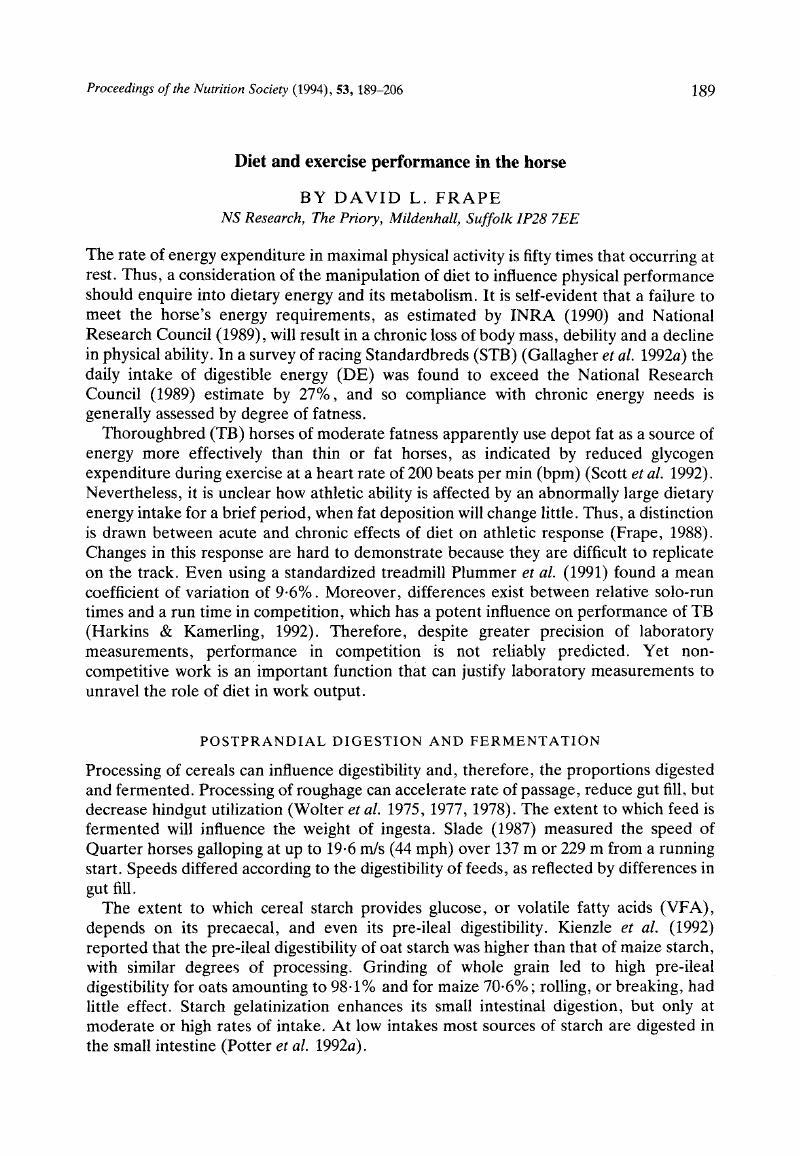Crossref Citations
This article has been cited by the following publications. This list is generated based on data provided by Crossref.
KRONFELD, D. S.
1996.
Dietary fat affects heat production and other variables of equine performance, under hot and humid conditions.
Equine Veterinary Journal,
Vol. 28,
Issue. S22,
p.
24.
Harris, P.
1997.
ENERGY SOURCES AND REQUIREMENTS OF THE EXERCISING HORSE.
Annual Review of Nutrition,
Vol. 17,
Issue. 1,
p.
185.
Meyer, H.
Flothow, C.
and
Radicke, S.
1997.
Preileal digestibility of coconut fat and soybean oil in horses and their influence on metabolites of microbial origin of the proximal digestive tract1).
Archiv für Tierernaehrung,
Vol. 50,
Issue. 1,
p.
63.
HYYPPä, S.
SAASTAMOINEN, M.
and
PÖSÖ, A. REETA
1999.
Effect of a post exercise fat‐supplemented diet on muscle glycogen repletion.
Equine Veterinary Journal,
Vol. 31,
Issue. S30,
p.
493.
Kaushik, S.J
1999.
Animals for work, recreation and sports.
Livestock Production Science,
Vol. 59,
Issue. 2-3,
p.
145.
2004.
Equine Nutrition and Feeding.
p.
568.
2004.
Equine Nutrition and Feeding.
p.
300.
Mattos, Fernando
Araújo, Kleber Villela
Leite, Gilberto Gonçalves
and
Goulart, Herbert de Moura
2006.
Uso de óleo na dieta de eqüinos submetidos ao exercício.
Revista Brasileira de Zootecnia,
Vol. 35,
Issue. 4,
p.
1373.
Brandi, Roberta Ariboni
Furtado, Carlos Eduardo
Martins, Elias Nunes
Freitas, Eduardo Villela Villaça
Queiroz-Neto, Antônio de
and
Lacerda-Neto, José Corrêa de
2010.
Parâmetros bioquímicos de equinos submetidos à simulação de prova de enduro recebendo dietas com adição de óleo de soja.
Revista Brasileira de Zootecnia,
Vol. 39,
Issue. 2,
p.
313.
Oliveira, R.N.
Marques Jr, A.P.
Xavier, P.R.
Alves, G.E.S.
Paes, P.R.O.
and
Gobesso, A.A.O.
2010.
Avaliação hematológica e bioquímica de equinos suplementados com óleo de arroz semirrefinado, rico em gamaorizanol.
Arquivo Brasileiro de Medicina Veterinária e Zootecnia,
Vol. 62,
Issue. 5,
p.
1043.
Nielsen, Brian D.
2013.
Equine Applied and Clinical Nutrition.
p.
261.
Katole, Shrikant
Das, A.
Agarwal, N.
Prakash, B.
Saha, S.K.
Saini, M.
and
Sharma, A.K.
2014.
Influence of work on nutrient utilisation in semicaptive Asian elephants (Elephas maximus).
Journal of Applied Animal Research,
Vol. 42,
Issue. 4,
p.
380.
Carvalho, M.G.
Akutagawa, T.Y M.
Nitta, T.Y.
Mazzante, N.M.G.
Silva, J.R.B.
Santarosa, B.P.
Rodrigues, C.A.
Hussni, C.A.
Alves, A.L.G.
and
Watanabe, M.J.
2020.
Efeito da suplementação com óleo de avocado (Persea americana Mill) na temperatura superficial corpórea de equinos antes e após exercício em esteira.
Arquivo Brasileiro de Medicina Veterinária e Zootecnia,
Vol. 72,
Issue. 5,
p.
1891.
Kaya, Zahit Kutalmış
Paksoy, Yavuzkan
and
Koluman, Nazan
2024.
Yas, Cinsiyet ve Besleme Metodunun Midilli Atlarında Bazı Vücut Ölçülerine Etkisi.
Hayvansal Üretim,
Vol. 65,
Issue. 1,
p.
59.



